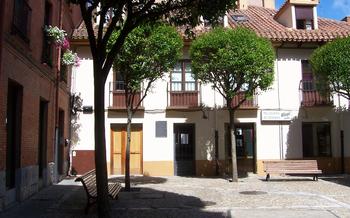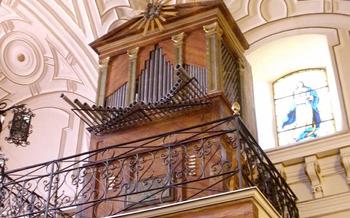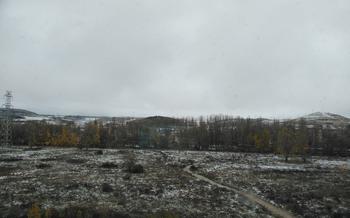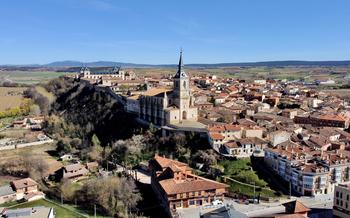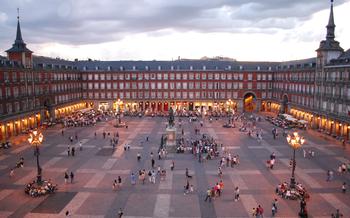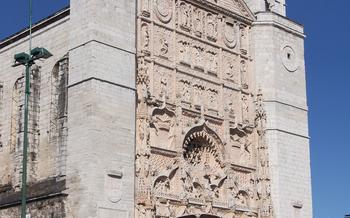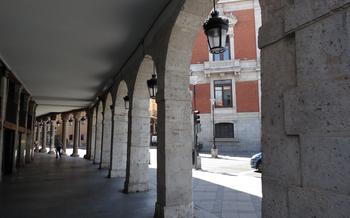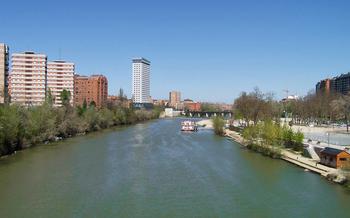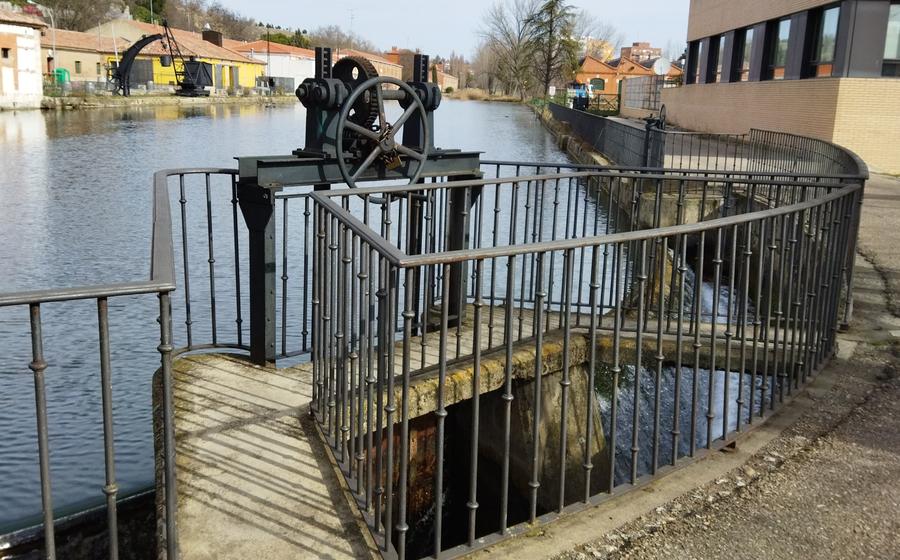
Canal de Castilla
- The Canal de Castilla: A Hidden Gem of Spanish Waterways
- Navigating the Canal: A Journey Through History
- Exploring the Canal by Bike: A Scenic Adventure
- Suggested Bike Routes and Trails
- Scenic Spots and Attractions to Discover
- Tips for a Safe and Enjoyable Cycling Experience
- Walking the Canal Towpaths: A Tranquil Stroll
- Visiting the Canal's Locks: A Marvel of Engineering
- Discovering the Canal's Bridges: Architectural Masterpieces
- Exploring the Canal's Museums: A Journey Through Time
- Savoring Local Cuisine: A Taste of the Region's Flavors
- Discovering Local Wineries: A Toast to the Region's Vineyards
- Unveiling Historical Sites: A Journey Through the Past
- Enjoying Nature's Beauty: A Haven for Wildlife and Landscapes
- Participating in Local Festivals: A Celebration of Culture and Tradition
- Shopping for Local Crafts: A Treasure Trove of Artisanship
- Accommodations Along the Canal: A Range of Options
- Insider Tip: Embracing the Slow Travel Philosophy
The Canal de Castilla: A Hidden Gem of Spanish Waterways
In the heart of Spain lies a hidden gem, the Canal de Castilla, a network of navigable waterways that once played a vital role in the region's transportation and trade. Constructed in the 18th and 19th centuries, this remarkable feat of engineering spans over 200 kilometers, connecting the provinces of Palencia, Valladolid, and Burgos.
The canal's unique features and attractions draw visitors from near and far. Its tree-lined towpaths, picturesque locks, and elegant bridges create a serene and enchanting atmosphere, perfect for leisurely strolls, cycling adventures, and boat trips. Along the way, travelers can admire stunning landscapes, diverse wildlife, and historical sites that tell the story of the region's rich cultural heritage.
Once a bustling artery of commerce, the Canal de Castilla transported agricultural goods, wool, and other products, contributing to the economic development of the region. Today, it stands as a testament to the ingenuity and perseverance of the people who built it, serving as a reminder of the important role waterways have played in shaping Spain's history and culture.
Navigating the Canal: A Journey Through History
There are several ways to explore the Canal de Castilla, each offering a unique perspective on its history and beauty. Boat trips are a popular option, allowing visitors to glide along the tranquil waters and admire the picturesque scenery. Various routes and itineraries are available, catering to different interests and preferences. Some popular routes include the Ruta del Norte, which takes you through the northern section of the canal, and the Ruta del Sur, which explores the southern section.
Along the way, you'll encounter numerous highlights and points of interest. Notable landmarks include the Puente de Hierro (Iron Bridge) in Medina de Rioseco, a beautiful example of 19th-century engineering, and the Acueducto de Medina del Campo, an impressive aqueduct that carries water over the canal. Villages and towns along the canal, such as Villanueva de Duero and Tordesillas, offer a glimpse into the region's rich history and culture.
To plan your canal boat journey, it's essential to consider the duration and difficulty level of the route. Some routes are suitable for beginners, while others require more experience. It's also important to book your boat in advance, especially during peak season, to avoid disappointment. Guided tours are available for those who prefer a more informative and structured experience.
Whether you choose to explore the canal by boat, bike, or on foot, the Canal de Castilla offers a captivating journey through history, nature, and culture. Embrace the tranquility of the waterways, discover hidden gems, and create lasting memories along the way.
Exploring the Canal by Bike: A Scenic Adventure
Cycling along the Canal de Castilla offers a unique and exhilarating way to experience its serene beauty and historical charm. With dedicated bike paths and trails running alongside the canal, cyclists of all levels can embark on a leisurely ride or a challenging adventure.
Suggested Bike Routes and Trails
The Canal de Castilla offers a variety of bike routes and trails catering to different preferences and fitness levels. The most popular route is the Sirga Path, a historic towpath that runs along the entire length of the canal. This flat and well-maintained path is ideal for families and casual cyclists, offering stunning views of the canal, its locks, and the surrounding countryside.
For more experienced cyclists, the Canal Loop is a challenging yet rewarding route that takes riders through the heart of the region. This circular route passes through picturesque villages, vineyards, and historical sites, offering breathtaking panoramas and a true sense of accomplishment.
Scenic Spots and Attractions to Discover
Cycling along the Canal de Castilla is not just about pedaling; it's about taking the time to explore the hidden gems and cultural treasures that dot the landscape. Along the way, cyclists can stop at charming villages like Medina de Rioseco and Villalón de Campos, where they can visit medieval churches, sample local delicacies, and soak up the authentic Spanish atmosphere.
Nature enthusiasts will delight in the diverse flora and fauna that thrive along the canal. Keep an eye out for a variety of bird species, including herons, egrets, and kingfishers, as well as otters, rabbits, and other wildlife.
Tips for a Safe and Enjoyable Cycling Experience
To make the most of your cycling adventure on the Canal de Castilla, here are a few tips to keep in mind:
-
Plan Your Route: Before you set off, research the different routes and choose one that suits your fitness level and interests.
-
Be Prepared: Bring plenty of water, snacks, and sun protection, as there are limited facilities along the canal.
-
Respect the Environment: Remember that the canal is a haven for wildlife and a source of water for local communities. Please cycle responsibly and leave no trace.
-
Enjoy the Ride: Take your time, soak up the scenery, and savor the unique experience of cycling along this historic waterway.
Walking the Canal Towpaths: A Tranquil Stroll
Strolling along the tranquil towpaths that parallel the Canal de Castilla offers a unique and serene way to explore its beauty and history. These well-maintained paths, originally designed for horses to pull barges, now provide a haven for walkers, joggers, and cyclists seeking a peaceful escape into nature.
The towpaths, which stretch for over 200 kilometers, offer a variety of routes and trails to suit different preferences and abilities. Gentle slopes and wide paths make them accessible to families with young children and those looking for a leisurely stroll, while more challenging routes with steeper inclines and uneven surfaces provide a workout for experienced hikers.
Along the way, walkers can marvel at the canal's engineering marvels, such as locks, bridges, and aqueducts, and admire the surrounding countryside, which bursts with color and life, especially during spring and summer. The towpaths also pass through charming villages and towns, where visitors can stop to explore the local history, culture, and gastronomy.
For a truly immersive experience, consider packing a picnic lunch and finding a secluded spot along the canal to enjoy a meal surrounded by nature's tranquility. Remember to bring comfortable shoes, water, and sunscreen, as well as binoculars if you're interested in birdwatching.
Visiting the Canal's Locks: A Marvel of Engineering
The Canal de Castilla boasts an impressive series of locks, marvels of engineering that played a crucial role in the canal's operation. These locks, some of which are still in use today, allowed boats to navigate the different levels of the canal, overcoming changes in elevation.
One of the most popular locks to visit is the "Esclusa 14" near Medina de Rioseco. This lock, built in the 18th century, is a testament to the ingenuity and skill of the canal's engineers. Visitors can marvel at its intricate mechanisms and witness the process of boats passing through the lock, a sight that transports them back in time.
Another notable lock is the "Esclusa 16" near Villabrágima. This impressive structure features a double chamber, allowing two boats to pass through simultaneously, a testament to the canal's efficiency and capacity.
To fully appreciate the locks' historical and technical significance, consider joining a guided tour. These tours offer insights into the operation and construction of the locks, providing a deeper understanding of their importance in the canal's history.
For those interested in witnessing the locks in action, plan your visit during the navigation season, typically from April to October. During this period, you can observe boats navigating the locks, a mesmerizing sight that showcases the canal's enduring functionality.
Remember to capture the beauty of these engineering marvels with your camera. The locks, with their unique architecture and picturesque surroundings, offer ample opportunities for stunning photographs.
Discovering the Canal's Bridges: Architectural Masterpieces
The Canal de Castilla is adorned with an array of stunning bridges, each a testament to the region's rich architectural heritage. These bridges, constructed in various styles, serve as a testament to the engineering prowess of their builders.
Architectural Styles and Designs
The bridges along the canal showcase a diverse range of architectural styles, from the elegant arches of the Romanesque era to the intricate ironwork of the Industrial Revolution. Some bridges, such as the Puente de la Reina, feature a combination of styles, reflecting the evolving architectural trends of the region.
Notable Bridges and Their Historical Significance
Among the notable bridges along the canal is the Puente de Palencia, an iconic structure that has stood for centuries. Built in the 16th century, this bridge features a series of pointed arches that create a striking silhouette against the backdrop of the canal. Another notable bridge is the Puente de Herrera de Pisuerga, a magnificent iron bridge that was constructed in the 19th century. This bridge, with its intricate latticework, is a testament to the engineering achievements of the industrial age.
Role of the Bridges in the Canal's Infrastructure
The bridges along the Canal de Castilla played a crucial role in the canal's operation. They allowed boats to cross over rivers and streams, ensuring the smooth flow of traffic along the waterway. The bridges also served as important landmarks, helping boatmen navigate their way along the canal.
Tips for Capturing Stunning Photos of the Bridges
To capture the beauty of the canal's bridges, photographers should consider using a wide-angle lens to capture the full grandeur of the structures. Experimenting with different shutter speeds can create interesting effects, such as blurring the water flowing beneath the bridges. For a unique perspective, photographers can take shots from the water level, using a boat or kayak to get close to the bridges.
Exploring the Canal's Museums: A Journey Through Time
Dotted along the Canal de Castilla, visitors can delve into the region's rich history and culture by visiting its captivating museums. These museums offer a diverse range of exhibits, from showcasing the canal's construction and operation to highlighting the region's artistic and archaeological heritage.
One of the must-visit museums is the Museo del Canal de Castilla in Palencia. This museum provides an immersive experience, taking visitors on a journey through the canal's history, from its conception and construction to its impact on the region's economy and society. Through interactive displays and historical artifacts, visitors can gain a deep understanding of the canal's significance and its role in shaping the region's identity.
Another notable museum is the Museo Etnográfico Provincial de Valladolid, located in the city of Valladolid. This museum showcases the traditional way of life in the region, with exhibits on rural life, agriculture, and traditional crafts. Visitors can explore the region's rich cultural heritage through displays of traditional costumes, tools, and everyday objects, providing a glimpse into the lives of the people who have lived and worked along the canal for centuries.
For those interested in art and archaeology, the Museo de Arte Contemporáneo de Castilla y León (MUSAC) in León is a must-visit. This modern and innovative museum features a diverse collection of contemporary art, including paintings, sculptures, and installations. Additionally, the Museo Arqueológico Provincial de Palencia houses a fascinating collection of archaeological artifacts from the region, providing insights into the ancient civilizations that have inhabited the area.
Visiting the Canal de Castilla's museums is an enriching experience that allows visitors to delve into the region's history, culture, and artistic heritage. These museums offer a unique opportunity to learn about the canal's significance and its impact on the region, providing a deeper understanding of the diverse and captivating world that surrounds this historic waterway.
Savoring Local Cuisine: A Taste of the Region's Flavors
The Canal de Castilla region boasts a rich culinary heritage, reflecting the diverse influences that have shaped its history. From traditional Castilian dishes to innovative modern cuisine, there's something to satisfy every palate along the canal.
Must-Try Dishes: - Lechazo asado: Slow-roasted suckling lamb is a regional specialty, known for its tender meat and crispy skin. - Queso castellano: A variety of cheeses are produced in the region, including creamy sheep's milk cheese and tangy goat's milk cheese. - Morcilla de Burgos: A type of blood sausage made with rice, spices, and pork blood, a local delicacy.
Local Markets and Festivals: - Mercado de abastos de Valladolid: A vibrant market in Valladolid where you can find fresh produce, local cheeses, and cured meats. - Feria de Tapas de Medina de Rioseco: An annual tapas festival held in Medina de Rioseco, offering a chance to sample a variety of regional dishes.
Tips for Savoring the Region's Gastronomy: - Visit local restaurants: Look for restaurants that specialize in traditional Castilian cuisine and use local ingredients. - Try tapas: Tapas bars are a great way to sample a variety of dishes in small portions. - Attend a cooking class: Learn to prepare some of the region's signature dishes in a hands-on cooking class.
Discovering Local Wineries: A Toast to the Region's Vineyards
The Castilla region, where the Canal de Castilla flows, is renowned for its winemaking tradition. With fertile soil and a favorable climate, the region produces a variety of exceptional wines that reflect the unique terroir of the area.
Indulge in Wine Tastings and Tours: Embark on a journey of flavors by visiting local wineries and cellars along the canal. Many wineries offer guided tours and tastings, where you can learn about the winemaking process, sample different vintages, and savor the region's best wines.
Explore Renowned Wine Regions: Discover the renowned wine regions of Ribera del Duero, Rueda, and Toro, all located within easy reach of the canal. These regions are home to prestigious wineries and vineyards, producing world-class wines that have earned international recognition.
Experience Local Wine Festivals: Immerse yourself in the region's wine culture by attending local wine festivals held throughout the year. These festivals celebrate the grape harvest, showcase local wineries, and offer opportunities to taste and purchase a variety of wines.
Tips for Wine Enthusiasts: - Plan your visit during the harvest season (September-October) to witness the bustling atmosphere of the wineries and vineyards. - Take advantage of the opportunity to purchase wines directly from the wineries, often at discounted prices. - Don't forget to savor local tapas and dishes that perfectly complement the region's wines.
Unveiling Historical Sites: A Journey Through the Past
As you journey along the Canal de Castilla, you'll be greeted by a tapestry of historical sites that transport you back in time. Explore the medieval towns and villages that have preserved their heritage, their cobblestone streets and ancient architecture whispering tales of bygone eras. Visit archaeological sites and excavations, where the secrets of the past are unearthed, revealing glimpses into the lives of those who came before.
Don't miss the opportunity to delve into the region's rich history. Discover castles and fortresses that once guarded the land, their imposing walls standing as testaments to the power and resilience of past civilizations. Immerse yourself in the stories of kings, queens, and valiant knights who shaped the destiny of this region.
As you explore these historical sites, let your imagination soar, picturing the events that unfolded within these walls, the triumphs and tragedies, the joys and sorrows that have left their mark on the landscape. Embrace the spirit of the past as you wander through these ancient ruins, allowing history to come alive before your very eyes.
Enjoying Nature's Beauty: A Haven for Wildlife and Landscapes
The Canal de Castilla meanders through a tapestry of diverse ecosystems, providing a sanctuary for a myriad of wildlife species. Birdwatching enthusiasts will delight in the opportunity to spot a variety of feathered creatures, including herons, egrets, and kingfishers, as they soar gracefully over the tranquil waters. Designated wildlife sanctuaries along the canal offer a closer look at the region's rich biodiversity, where visitors can observe otters, beavers, and turtles in their natural habitats.
The picturesque landscapes that surround the canal create a captivating backdrop for nature lovers. Scenic viewpoints offer panoramic vistas of rolling hills, lush forests, and vibrant fields, inviting travelers to capture the essence of the region's natural beauty. Whether it's a tranquil walk amidst the serene surroundings or a leisurely bike ride through verdant trails, the canal offers ample opportunities to embrace the tranquility and splendor of the natural world.
Remember to tread lightly and respect the delicate ecosystems you encounter. Embrace responsible wildlife viewing practices by maintaining a safe distance from animals, avoiding disturbing their habitats, and leaving no trace of your presence. By doing so, you contribute to the preservation of this unique natural haven for future generations to appreciate.
Participating in Local Festivals: A Celebration of Culture and Tradition
Immerse yourself in the vibrant cultural tapestry of the Canal de Castilla region by attending one of the many local festivals and events that take place throughout the year. These celebrations offer a unique opportunity to witness the region's rich traditions and customs firsthand, interact with friendly locals, and experience the infectious energy that fills the air.
From traditional folk festivals showcasing traditional music, dance, and costumes to culinary events highlighting the region's delectable cuisine, there's something for every taste and interest. Join in on the lively processions, marvel at the elaborate costumes, and savor the mouthwatering local dishes as you become part of the vibrant festivities.
Don't miss the chance to witness the colorful Carnival celebrations, where streets come alive with parades, music, and dancing, or the solemn processions during Semana Santa (Holy Week), where religious devotion and artistry intertwine. Each festival is a testament to the region's deep-rooted cultural heritage, providing a glimpse into the lives and customs of its people.
Before your visit, be sure to research local festival dates and plan your itinerary accordingly. Embrace the spirit of celebration, mingle with the locals, and let the infectious energy of these events transport you to the heart of Spanish culture.
Shopping for Local Crafts: A Treasure Trove of Artisanship
The Canal de Castilla region is renowned for its rich artisanal heritage, offering a treasure trove of unique and handcrafted souvenirs for visitors. Explore the charming villages and towns along the canal to discover a world of traditional crafts and local artisans.
Stroll through bustling markets, where vendors display their handmade creations, from intricate ceramics and glassware to delicate lace and embroidery. Admire the skill and artistry of local craftsmen as they demonstrate their techniques, preserving centuries-old traditions.
Visit workshops and studios, where you can witness artisans at work and gain insights into their creative processes. Learn about the history and cultural significance of each craft, and perhaps even try your hand at creating your own masterpiece.
Discover unique souvenirs, such as hand-painted tiles, decorative pottery, woven baskets, and intricate jewelry. These handcrafted items make for cherished mementos of your journey along the canal, capturing the essence of the region's rich cultural heritage.
Support local artisans by purchasing their products. Not only will you take home a piece of the region's artistry, but you'll also contribute to preserving traditional crafts and supporting the local economy.
Accommodations Along the Canal: A Range of Options
When planning your journey along the Canal de Castilla, finding suitable accommodations is essential for a comfortable and enjoyable experience. Fortunately, there is a diverse range of options to cater to different preferences and budgets.
In the charming towns and villages that dot the canal's path, you'll find a selection of cozy hotels and guesthouses. These establishments offer a warm and welcoming atmosphere, often with traditional decor and personalized service. For a more immersive experience, consider staying in a historic building or a renovated mill house along the canal.
If you prefer the freedom and flexibility of self-catering, there are several campsites located near the canal. These campsites offer basic facilities such as tent pitches, campervan hookups, and shared bathrooms. They provide an excellent base for exploring the canal and the surrounding countryside at your own pace.
For a truly unique and unforgettable experience, consider renting a houseboat or a narrowboat. These floating accommodations allow you to travel along the canal at a leisurely pace, stopping at picturesque spots to soak in the scenery and enjoy the tranquility of the waterways.
When booking your accommodations, it's advisable to plan ahead, especially during the peak tourist season. Reservations are recommended to avoid disappointment, particularly if you have specific preferences or require accessible facilities.
Insider Tip: Embracing the Slow Travel Philosophy
In the era of fast-paced travel, the Canal de Castilla offers a unique opportunity to embrace the slow travel philosophy. Slow travel is not just about spending more time at each destination; it's about slowing down the pace of your journey and savoring every moment.
When you travel slowly, you have the chance to fully immerse yourself in the local culture and connect with the people and places you visit. You can wander through the charming villages, engage in conversations with the locals, and truly appreciate the region's unique way of life.
Embrace the slow pace of life along the canal by taking leisurely walks or bike rides along the towpaths, stopping at quaint cafés for a cup of coffee or indulging in a traditional Spanish meal at a local restaurant. Visit the local markets, chat with the vendors, and pick up some fresh produce or handmade souvenirs.
Take the time to explore the region's historical sites and museums, learning about the rich history and culture of the area. Immerse yourself in the natural beauty of the canal, spotting wildlife, admiring the stunning landscapes, and simply enjoying the peace and tranquility of the surroundings.
Slow travel is not just about seeing more; it's about experiencing more. It's about connecting with the destination on a deeper level and creating lasting memories that will stay with you long after your journey ends.
